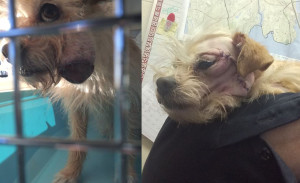 Shelter & Rescue
Shelter & Rescue  No Comments
No Comments Rescue Dogs with Brucellosis Imported into Canada from Southern US and Mexico
We hate to keep pounding the same drum, but this is such a serious and growing issue, we feel it would be irresponsible not to report it:
Canine Brucella Imported to Alberta, Canada from Southern US and Mexico Rescue Dogs
Brucellosis is a particularly nasty disease, caused by the Brucella canis bacterial organism that leads to illness and infertility in dogs. It is zoonotic, which means it can be passed along to humans, though this is rare.
Here is NAIA Board Member Marty Greer, DVM, JD, with a summary of Canine brucellosis, and what it means for dogs and dog owners:
Canine brucellosis is a serious threat to the breeding program of any dog breeder. Canine brucellosis is infrequently diagnosed in the US and Canada. The threats are two-fold. The first threat is to human health – any disease that can be spread to humans, as canine brucellosis can be, is a concern. Although it rarely is transmitted to humans, the threat is real, particularly for those with immunocompromised health. The second threat is the damage done to a breeding program. Dogs infected with Brucella canis are at the least neutered or spayed and placed on long term antibiotics. In some cases, the recommendations are to euthanize the infected animals because of the difficulty and expense associated with successful treatment. Dogs in an infected home or facility are repeatedly tested and isolated from other dogs for months at a time. Infected dogs can no longer be in a breeding program. For those breeders who have spent a lifetime developing their genetic lines of dogs, this can be devastating, emotionally and financially.
Canine brucellosis can be tested for in reference laboratories and in house in many veterinary clinics. The test used for in house testing is relatively old technology, but it is very sensitive, meaning the test is unlikely to miss a dog that is infected with Brucella canis. Consider testing all dogs in a breeding program or leaving a breeding program for B. canis prior to moving the dogs or allowing them into your home or facility to prevent this crisis.
Unlike rabies, which is the disease most often focused on when discussing the irresponsible transfer of rescue dogs, brucellosis isn’t a death sentence. But it is a very serious illness — aside from the ethical issues of irresponsibly spreading disease, it is of incredible concern to people who are trying to responsibly breed dogs, as well as those who want to bring a deliberately bred dog with predictable traits into their family!




